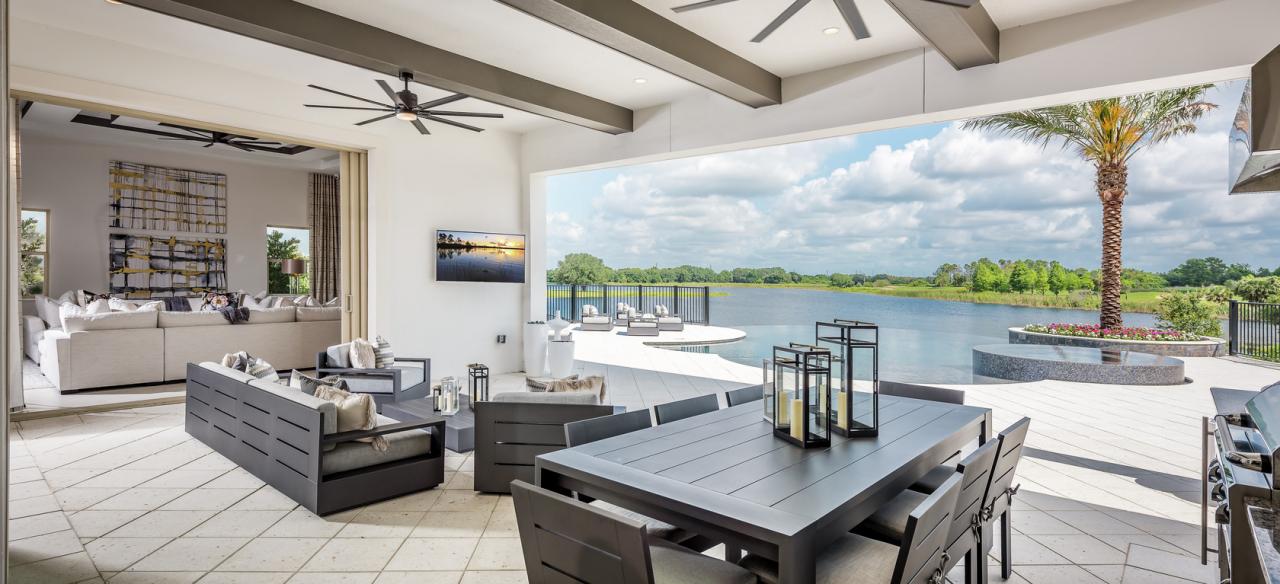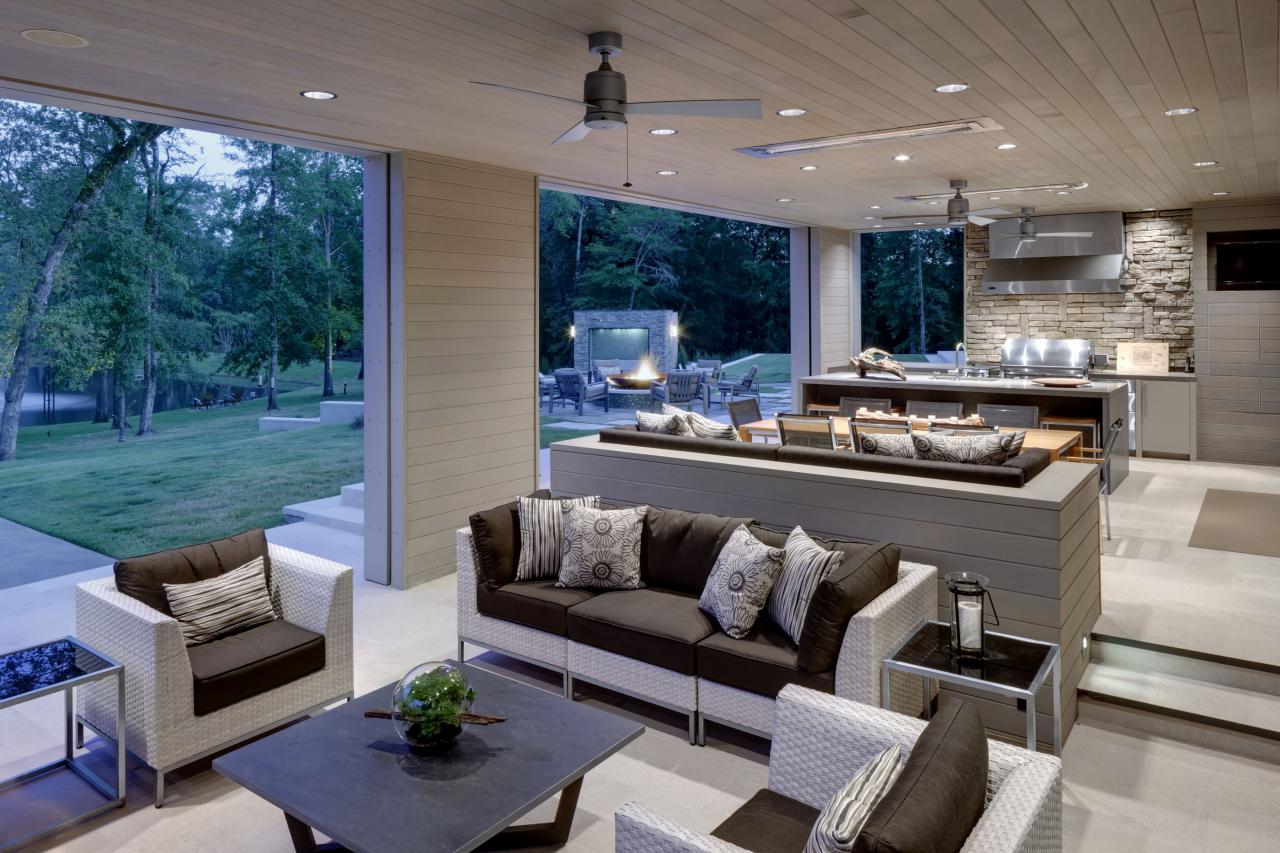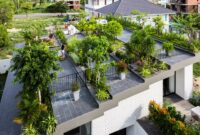Indoor-outdoor living space ideas are transforming how we experience our homes, blurring the lines between interior and exterior environments. This approach fosters a seamless flow, bringing the tranquility of nature indoors and extending the functionality of your living space outwards. We’ll explore design elements, furniture choices, practical considerations, and technological integrations to help you create your own haven where indoor comfort meets outdoor serenity.
From carefully selecting weather-resistant materials for furniture to strategically incorporating lighting to enhance the transition between spaces, the possibilities are vast. We’ll delve into various design styles, showcasing how different aesthetics can be achieved while maintaining that crucial sense of cohesion. Whether you dream of a minimalist sanctuary or a vibrant bohemian oasis, we’ll provide the inspiration and guidance to make your vision a reality.
Defining Indoor-Outdoor Flow

Source: tollbrothers.com
Creating a seamless transition between your indoor and outdoor living spaces is key to maximizing comfort and enjoyment. It’s about blurring the lines, making the outdoors feel like an extension of your home, and vice-versa. This is achieved through careful consideration of architectural elements, material choices, and strategic lighting design.
Architectural Features for Seamless Transition
Architectural features play a crucial role in establishing a fluid connection between indoor and outdoor areas. Large windows, sliding glass doors, and retractable walls effectively minimize the visual barrier between spaces. Consider extending the flooring material from indoors to outdoors to create a unified aesthetic. For example, extending hardwood flooring onto a covered patio with a similar-toned tile creates a cohesive feel.
Similarly, architectural details like arches or columns can be mirrored on both sides of the transition to unify the spaces visually. A wide doorway or a series of French doors can create a grand entrance to an outdoor living area, visually welcoming guests and making the transition feel natural.
Material Choices for Cohesive Aesthetics
The materials used in both your indoor and outdoor spaces should complement each other to enhance the sense of flow. Natural materials, such as stone, wood, and bamboo, work particularly well, creating a harmonious and organic feel. For example, using the same type of stone for indoor flooring and outdoor paving creates a visual connection. Similarly, extending the use of wood from indoor beams to outdoor decking creates a sense of continuity.
If using more modern materials like concrete, consider using similar textures and colours inside and out to maintain a cohesive aesthetic. The aim is to create a visual harmony, making the transition feel effortless.
Lighting to Enhance Spatial Flow
Lighting is a powerful tool for enhancing the flow between indoor and outdoor spaces. Using consistent lighting styles and temperatures throughout both areas creates a unified atmosphere. Consider extending the same lighting fixtures or styles from indoors to outdoors. For instance, pendant lights indoors could be mirrored with similar-style outdoor lanterns. Strategically placed outdoor lighting can illuminate pathways and highlight architectural features, extending the ambiance of the indoor space to the outdoors.
Dimmable lighting allows for adjusting the brightness to suit the time of day and mood, further enhancing the fluidity between spaces.
Design Styles for Indoor-Outdoor Living
| Style | Key Features | Material Palette | Lighting Examples |
|---|---|---|---|
| Minimalist | Clean lines, simple forms, uncluttered spaces, emphasis on functionality. | Neutral colours (white, grey, beige), natural materials (wood, stone), metal accents. | Recessed lighting, minimalist pendant lights, sleek outdoor spotlights. |
| Bohemian | Eclectic mix of patterns, textures, and colours, relaxed and informal atmosphere, abundance of textiles and plants. | Rich jewel tones, earthy colours, natural fibres (cotton, linen, jute), wood, metal. | String lights, lanterns, candles, colourful stained-glass lamps. |
| Traditional | Classic and elegant design, symmetrical layouts, ornate details, emphasis on comfort and luxury. | Warm wood tones, elegant fabrics (velvet, silk), stone, marble, antique accents. | Chandeliers, sconces, classic outdoor lanterns, pathway lighting. |
| Modern | Sleek lines, geometric shapes, innovative materials, emphasis on functionality and technology. | Neutral colours, glass, metal, concrete, high-tech materials. | LED strip lighting, track lighting, integrated lighting fixtures, smart outdoor lighting systems. |
Furniture and Decor Selection: Indoor-outdoor Living Space Ideas
Creating a seamless indoor-outdoor flow extends to the careful selection of furniture and decor. The key is choosing pieces that complement both spaces aesthetically and function practically in diverse environments. This requires considering materials, styles, and the overall ambiance you wish to achieve.Choosing furniture that effortlessly transitions between indoor and outdoor use is crucial for maximizing space and creating a unified aesthetic.
This involves selecting pieces durable enough to withstand the elements while maintaining an elegant appeal indoors.
Weather-Resistant Furniture Materials
Weather-resistant materials are essential for outdoor furniture to ensure longevity and beauty. Popular choices include wicker (often synthetic for increased durability), aluminum (lightweight and rust-resistant), teak (a naturally weather-resistant hardwood), and powder-coated steel (provides a protective layer against rust and corrosion). These materials not only stand up to sun, rain, and temperature fluctuations but also offer a variety of styles to suit different tastes.
Indoor-outdoor living is all about blurring the lines between your home and the garden. Creating this seamless flow is easier than you think, especially with clever design choices. Check out some inspiring ideas on achieving this with Affordable contemporary home design which often incorporates large windows and sliding doors. This style perfectly complements the desire for a connected indoor-outdoor living space, maximizing natural light and creating a relaxing atmosphere.
For example, a sleek aluminum dining set can transition seamlessly from a patio to a sunroom, while a classic teak bench adds a touch of rustic elegance to both outdoor and indoor spaces. Similarly, synthetic wicker offers a stylish alternative to natural wicker, providing the same aesthetic appeal with greater resistance to moisture and UV damage.
Decorative Accessories for Indoor-Outdoor Use
Decorative accessories play a vital role in unifying indoor and outdoor spaces. Think about using textiles like outdoor-rated rugs and cushions in weather-resistant fabrics such as Sunbrella, which are designed to withstand UV rays, moisture, and fading. These can easily be moved between rooms and patios, creating a cohesive feel. Pottery, especially glazed ceramics or durable resin planters, can house plants indoors or outdoors, adding a pop of color and texture.
Indoor-outdoor living is all the rage, blurring the lines between home and garden. This seamless transition is perfectly complemented by the clean lines and functionality of Latest minimalist house trends , which often prioritize open-plan designs and large windows to maximize natural light and the connection with the outdoors. Ultimately, creating a fluid indoor-outdoor space enhances both comfort and style.
Metal sculptures or lanterns, if appropriately treated to resist rust, can also create visual continuity between the two areas. Consider using neutral-toned accessories such as cushions and throws to easily shift between indoor and outdoor settings. These pieces can effortlessly change the look of the space without compromising durability.
Plants for Varying Sunlight Exposure
Choosing the right plants is key to enhancing the beauty and atmosphere of your indoor-outdoor space. Consider the amount of sunlight each area receives to select plants that will thrive.
- Full Sun (6+ hours): Lavender, Rosemary, Salvia, Sedum. These hardy plants tolerate intense sunlight and heat.
- Partial Sun (4-6 hours): Hostas, Begonias, Impatiens, Fuchsias. These plants prefer morning sun or filtered light.
- Shade (less than 4 hours): Ferns, Coleus, Astilbe, Hostas (some varieties). These plants thrive in shady areas and require protection from harsh sunlight.
Careful plant selection ensures a vibrant and healthy landscape, adding to the overall appeal of your indoor-outdoor living space. Remember to consider the size and growth habit of each plant to ensure it fits comfortably in its chosen location.
Enhancing the Outdoor Space
Creating a seamless transition between your indoor and outdoor living areas requires careful consideration of the outdoor space itself. A well-designed outdoor area extends the functionality and aesthetic appeal of your home, providing a comfortable and inviting environment for relaxation, entertaining, and enjoying the natural world. This section will explore several key elements for enhancing your outdoor space.
Outdoor Kitchen and Dining Area Design
A functional outdoor kitchen and dining area can significantly elevate your outdoor living experience. Consider the size and layout based on your needs and available space. A simple setup might include a built-in grill, a countertop with a sink, and ample storage. More elaborate designs could incorporate a pizza oven, refrigerator, and even a full-size range. The dining area should complement the kitchen, offering comfortable seating for guests.
Materials like weather-resistant wood, stainless steel, and durable stone are ideal for both durability and aesthetic appeal. Careful placement of lighting, both ambient and task lighting, will enhance usability in the evening. For example, a L-shaped countertop design could maximize workspace while allowing for easy access to the grill and dining area.
Outdoor Flooring Options
The choice of outdoor flooring significantly impacts both the aesthetics and functionality of your outdoor space. Several options exist, each with varying degrees of suitability for different climates. For example, pavers (stone, brick, concrete) offer durability and are suitable for most climates, withstanding temperature fluctuations and heavy foot traffic. Natural stone, such as flagstone or slate, provides a more rustic and natural look but may require more maintenance.
Decking (wood, composite) offers a warm and inviting feel but requires regular cleaning and sealing, especially in humid climates. Concrete is a cost-effective and durable option, but its aesthetic appeal can be enhanced with staining or texturing. Finally, gravel or pea gravel provides a low-maintenance, permeable surface suitable for drier climates but may be less comfortable underfoot.
Creating a Relaxing Outdoor Seating Area with Varying Privacy Levels
Designing a relaxing outdoor seating area involves thoughtful consideration of comfort, privacy, and aesthetics. The level of privacy can be adjusted through various design elements. For maximum privacy, consider enclosing the seating area with tall hedges, bamboo screens, or a pergola with climbing plants. Partial privacy can be achieved with strategically placed planters or freestanding screens. Comfortable seating is crucial; options range from cushioned outdoor sofas and armchairs to weather-resistant wicker furniture.
Indoor-outdoor living is all about blurring the lines between your home and the great outdoors. Creating a seamless transition often involves using materials and design elements that work in both spaces. For example, an industrial aesthetic, like you might see in a stunning Industrial-style home design , can easily extend from inside to a patio or deck using exposed brick, metal accents, and large windows.
This creates a cohesive and stylish flow between indoor and outdoor living areas.
Adding soft textiles, such as outdoor cushions and throws, enhances comfort and visual appeal. Incorporating ambient lighting, such as string lights or lanterns, creates a warm and inviting atmosphere, especially in the evenings. For example, a secluded corner with lush greenery and a comfortable hammock provides a private and tranquil retreat.
Outdoor Water Feature Integration
An outdoor water feature can add a captivating focal point to your landscape and create a soothing ambiance. A small pond with aquatic plants can attract wildlife and provide a calming visual element. The pond’s shape and size should complement the overall design of the outdoor space. A fountain, either freestanding or integrated into a wall or pond, adds a dynamic element with the sound of flowing water.
The design of the fountain can range from simple and minimalist to elaborate and ornate. Materials such as natural stone, ceramic, or metal can be used to create a water feature that complements the existing aesthetic. For example, a sleek, modern fountain made of stainless steel could be incorporated into a contemporary outdoor space, while a rustic stone fountain might suit a more traditional setting.
Careful consideration of water flow, pump size, and lighting will ensure the water feature functions effectively and enhances the overall aesthetic appeal.
Incorporating Technology and Amenities

Source: tollbrothers.com
Extending the comfort and convenience of your indoor living space seamlessly into the outdoors requires thoughtful integration of technology and amenities. This allows you to enjoy your outdoor area regardless of the time of day or weather conditions, transforming it into a true extension of your home. By incorporating smart technology and carefully selected amenities, you can create a sophisticated and enjoyable outdoor experience.Smart home technology offers a wealth of possibilities for enhancing your outdoor living space.
Imagine controlling every aspect of your outdoor environment from the palm of your hand, creating the perfect ambiance for any occasion. This level of control and convenience significantly improves the overall user experience and elevates the enjoyment of your outdoor area.
Indoor-outdoor living spaces are all about blurring the lines between your home and the garden. To make this style truly sustainable, consider incorporating smart design choices, such as those found in Energy-efficient home design ideas , to minimize energy consumption. For example, strategic window placement and natural ventilation can create a comfortable and eco-friendly indoor-outdoor flow, maximizing the benefits of both.
Smart Home Integration for Outdoor Control
Integrating smart home technology allows for centralized control of lighting, music, and climate in your outdoor space. Smart lighting systems enable you to adjust brightness and color temperature remotely, setting the mood for everything from a relaxed evening to a vibrant party. Similarly, smart speakers or sound systems provide high-quality audio, allowing you to stream your favorite music or podcasts effortlessly.
Smart thermostats, integrated with weather sensors, can automatically adjust the temperature of outdoor heating or cooling systems, maintaining optimal comfort levels throughout the day. For example, the Nest Learning Thermostat can be paired with outdoor sensors to preemptively adjust the temperature based on predicted weather changes.
Outdoor Heating and Cooling Solutions
Several options exist for maintaining a comfortable temperature in your outdoor space, regardless of the season. Outdoor heaters, ranging from patio heaters to built-in infrared systems, provide warmth during cooler evenings. For example, a propane patio heater offers a quick and portable solution, while an infrared system provides more even and consistent heat. Conversely, misting systems or outdoor fans can provide cooling relief during warmer months.
A well-designed system might incorporate both heating and cooling elements for year-round comfort. For instance, a combination of a retractable awning and ceiling fans can provide shade and airflow during the summer, while infrared heaters can provide warmth in the winter.
Outdoor Entertainment System Design, Indoor-outdoor living space ideas
Creating a dedicated outdoor entertainment area elevates the experience of spending time outdoors. A projector and screen combination allows for movie nights under the stars, while a high-quality sound system ensures crisp and clear audio. Consider weatherproof speakers designed for outdoor use to ensure longevity and durability. The placement of the projector and screen should take into account ambient light and viewing angles for optimal viewing.
For instance, a retractable screen can be easily stored away when not in use, protecting it from the elements. Similarly, embedding speakers into the landscape design can provide a more integrated and aesthetically pleasing solution.
Outdoor Lighting Scheme Design
A well-planned outdoor lighting scheme enhances both ambiance and security. Layered lighting, combining ambient, task, and accent lighting, creates a welcoming and functional space. Ambient lighting, such as string lights or pathway lights, sets the overall mood. Task lighting, such as spotlights illuminating specific areas, provides functionality. Accent lighting, such as uplighting on trees or shrubs, highlights architectural features and landscaping.
Motion-sensor lights provide added security, deterring intruders while providing illumination when needed. For instance, strategically placed solar-powered path lights can illuminate walkways while minimizing environmental impact. Consider using warm-toned lighting for a cozy ambiance and cooler tones for brighter, more functional illumination.
Addressing Practical Considerations

Source: pinimg.com
Creating a seamless indoor-outdoor living space offers numerous benefits, but it’s crucial to address potential practical challenges to ensure a truly enjoyable and functional area. Careful planning and proactive solutions can prevent many issues and maximize the longevity and enjoyment of your space.Potential challenges often arise from the inherent differences between indoor and outdoor environments. These differences require thoughtful consideration to create a harmonious and resilient space that withstands the elements and remains comfortable and safe for years to come.
Pest Control Methods for Outdoor Areas
Effective pest control is essential for maintaining a pleasant outdoor living space. Different methods exist, each with its own advantages and disadvantages. Choosing the right approach depends on factors like the type of pests, the size of the area, and personal preferences regarding environmental impact.
- Chemical Pesticides: These offer quick and effective results but can harm beneficial insects, pets, and even humans if not used carefully. They can also pollute the environment. Responsible use involves following label instructions meticulously and considering less-toxic alternatives whenever possible.
- Natural Pest Control: This approach utilizes natural predators (like ladybugs for aphids), beneficial plants (like marigolds to repel mosquitoes), and natural repellents (like neem oil). While generally safer for the environment and people, it may require more time and effort to achieve effective control.
- Integrated Pest Management (IPM): This combines both chemical and natural methods in a strategic way. It focuses on monitoring pest populations and using the least-toxic methods first, only resorting to chemical interventions when absolutely necessary. IPM is often the most sustainable and effective long-term approach.
Drainage and Waterproofing in Outdoor Living Spaces
Proper drainage and waterproofing are critical for preventing damage to your structure and ensuring the longevity of your outdoor living area. Water damage can lead to mold growth, structural deterioration, and costly repairs.Effective drainage systems divert rainwater away from the living space, preventing water accumulation that can lead to flooding and erosion. This can involve grading the land, installing drainage pipes, and creating swales or other water-management features.
Waterproofing techniques, such as using waterproof materials for flooring and walls, applying sealants, and ensuring proper flashing around windows and doors, are essential to protect against water infiltration. Ignoring these aspects can lead to significant problems down the line.
Creating a Sustainable and Environmentally Friendly Indoor-Outdoor Space
Designing a sustainable outdoor living space minimizes environmental impact while maximizing enjoyment. Several strategies can help achieve this goal.
- Choosing Sustainable Materials: Opt for locally sourced, recycled, or sustainably harvested materials for construction and furnishings. Examples include reclaimed wood, bamboo, and recycled plastic lumber.
- Water Conservation: Incorporate drought-tolerant landscaping, utilize rainwater harvesting systems, and install low-flow fixtures to reduce water consumption.
- Energy Efficiency: Use energy-efficient lighting (LEDs), consider solar power for lighting or other needs, and design the space to maximize natural ventilation and minimize reliance on air conditioning.
- Waste Reduction: Choose durable, long-lasting materials to reduce the need for replacements. Compost food scraps and yard waste to reduce landfill waste.
Epilogue

Source: architecturaldigest.com
Creating a successful indoor-outdoor living space is about more than just aesthetics; it’s about crafting a lifestyle. By thoughtfully considering design elements, furniture choices, and practical considerations, you can transform your home into a haven that seamlessly blends the best of both worlds. Remember, the key is to create a cohesive and functional space that reflects your personal style and enhances your everyday life.
Embrace the possibilities and enjoy the seamless flow between your indoor and outdoor realms.
FAQ Insights
What are some budget-friendly ways to achieve an indoor-outdoor flow?
Repurposing existing furniture, using affordable natural materials like wood and stone, and DIYing some elements (like a simple planter box) can significantly reduce costs. Strategic lighting with inexpensive string lights or lanterns can also make a big difference.
How do I deal with insects and pests in my outdoor living space?
Consider using natural pest deterrents like citronella candles or plants known to repel insects. Regular cleaning and maintaining a tidy space can also minimize pest problems. For more serious infestations, consult a pest control professional.
What about privacy concerns when designing an outdoor living area?
Strategic planting of tall shrubs or trees can offer natural screening. Consider using privacy screens, fences, or pergolas to create defined boundaries and enhance your sense of seclusion.
How can I make my outdoor living space energy-efficient?
Choose energy-efficient outdoor lighting (LEDs), utilize solar-powered features where possible, and consider installing smart home technology to control lighting and appliances remotely, minimizing energy waste.



